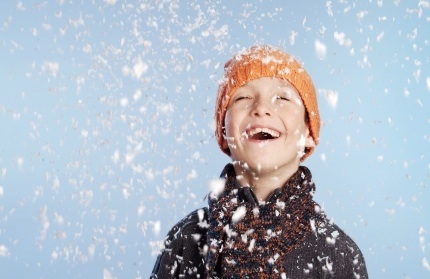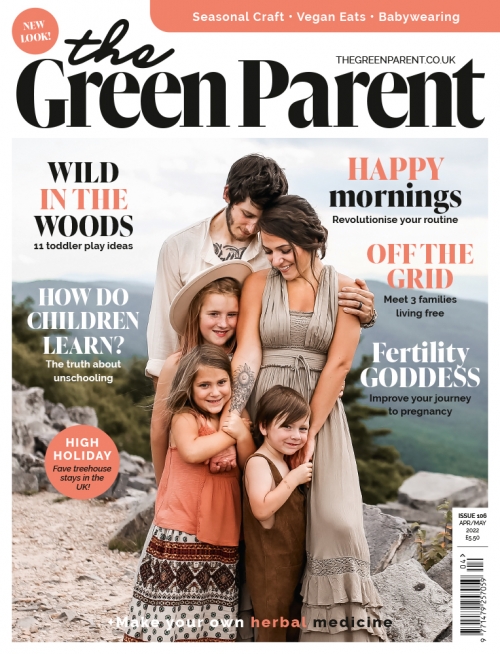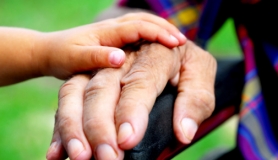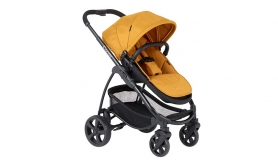‘How are snowflakes made, Mummy?’ No idea, better Google it. Wow, type in snowflake and a treasure trove of links spills out! Where to start first? We begin with Wikipedia, which gives us the basic information on how snow crystals form when supercooled cloud droplets freeze, and via the Wegner-Bergeron-Findeison process these crystals grow, then fall through the sky and stick together to form snowflakes. Eeek, physics! It all sounds a bit like gobbledygook but we get the general gist of it and read on. Geometry next. The type of snowflake formed depends on the temperature, with a myriad of different types, from needles to flat plates to the more extravagantly-decorated dendritic (treelike) forms.
Crystals everywhere
We follow the links to snowcrystals.com, the website created by Kenneth Libbrecht, professor of physics at Caltech and clearly something of a snowflake nut. We find out why snow looks white (reflected light) and that the majority of snowflakes are not actually symmetrical, it’s just that the symmetrical ones are the prettiest and hence most photographed ones. Here are pages of fascinating information on snowflake geometry, more physics on how they form, lovely pictures, kids’ activities, books, snowflake hotspots and on and on. And, oh my, a guide to making your very own snowflakes! Wow, all you need is some dry ice, a plastic bottle and some Styrofoam cups. Hmmm, not sure where you find dry ice but there’s a project for a rainy day… Or failing that, move to a country where it snows properly and set up your own apparatus for photographing snowflakes under a microscope, with a kit listed down to the very last nut and bolt for doing so.

History of discovery
The history of snowflake discovery draws us in next, with philosopher and mathematician René Descartes describing snow crystal morphologies (types of structures) in 1635, using purely the naked eye. The next famous name is that of Robert Hooke, natural philosopher and polymath. Using the newly-invented microscope to sketch snowflakes in 1665, these were published in his Micrographia. Something to explore later on, better bookmark that page so we can find out more about these fascinating renaissance men in future.
Snow photography
Most intriguing of all is Wilson ‘Snowflake’ Bentley, the first person to photograph snowflakes in 1885, publishing his book Snow Crystals in 1931. We follow the link to his site and that of the Buffalo Museum of Science to find out more about this character. He was a farmer, home-educated and lived in rural Vermont, living all his life in the farmhouse where he was born. Tragically, despite devoting his life to studying snowflakes, he died of pneumonia after being caught in an ironic snowstorm, and made little money out of his fabulous images.
My son Max is captivated by the story of this man, with his luxuriant moustache and stiff demeanour, who combined so many talents in such a quiet life. At once photographer, naturalist, physicist, artist, writer, meteorologist, musician, inventor and innovator, his story is truly inspirational. The locals may have laughed at this odd man, preoccupied by snowflakes and photographing them, but his scientific curiosity and driving passion has made him famous beyond his lifetime, and his book is still in print. We order his book, ‘Snow Crystals’ online and ooh and aah at the weird, wonderful and bizarre images of 200 different kinds of snowflake in spectacular black and white simplicity. Kenneth Libbrecht has also published some beautiful photographic books of snowflakes (e.g. The Art of the Snowflake). These snowflake photos are much more modern, shiny and exquisitely detailed.
Virtual paper snowflakes
Time for a little brain break. So we make online snowflakes. Our versions are beautiful but a bit feeble compared with the intricate patterns created by some of the experts out there on the worldwide web, with Christmas bells, Halloween skulls and love hearts all somehow fashioned out of a bit of virtual snipping. We bookmark a couple of sites on making paper snowflakes for when we’re in the mood for real-life snipping. We have a little drool over some gorgeous snowflake biscuits on Goodies! by Anna, a blog about baking which is definitely one to come back to when the baking mood hits.
Fractal images
We have a look at the Koch method of making snowflakes by combining triangles (actually, this is in the context of cutting up a large brownie into triangles but hey, it’s maths right?) This leads us onto finding out about the Koch snowflake or star, which is a type of fractal, in fact the earliest mathematical curve to be discovered. Fractals are shapes characterized by self-similarity. Yes, I know, I don’t understand that last sentence either. Such beautiful pictures though, each one incredibly intricate, swirly, colourful and unique.
We visit Sprott’s fractal gallery, where a ‘fractal of the day’ is to be found, generated automatically using computer programs designed by some awesomely clever boffins. The maths behind the images is incomprehensible to me (‘transcendental functions’ or ‘quartic variations of Ushikis’s “Phoenix” Julia set equations’ anybody?). However, the resulting riot of psychedelia is complex, exquisite and mind-bendingly patterned. Paul Carlson’s fractals are particularly beautiful and a riot of colour, with several different kinds of forms resulting in bubble pictures, incredible ‘gardens’ of fractals and shapes ranging from face-like to rainbows to stars.
“Fractals are not just the weird and wonderful results of mathematical equations, they are found in nature as a matter of course.”
Natural patterns
Fractals are not just the weird and wonderful results of mathematical equations, they are found in nature as a matter of course. Trees, ferns, crystals, blood circulation systems and even broccoli heads are all examples. As are, of course, snowflakes. Well, so much for that brain break, time for some trivia.
Weather lore
Back to Wikipedia. We find out about the Siberian orange snow of 2007, when a sandstorm in nearby Kazakhstan caused smelly, oily orange snow to fall over 580 square miles in Siberia. We already know about the causes of yellow snow, of course… Watermelon snow is new to us though, with the colour and smell of watermelon arising from red-coloured ‘green’ algae. Black snow, or ‘snirt’ is familiar to us all as that horrid slushy roadside stuff which forms when snow becomes dirty, but in prairie regions of North America it arises from black topsoil from fields being deposited in towns and can transform a town full of white snow to one covered in black snow literally overnight.
Eskimo for snow
Last stop on the snow-fact express. We find out that the famed huge number of different Eskimo words for snow is in fact an urban myth. The reasons for the myth are complex, but include an inflation of the original number by various media sources, the number of different Eskimo languages and the structure of those languages. Eskimo languages are polysynthetic, meaning they can combine words into compound words which would be phrases in other languages. Another fabulous way of putting this is to call them ‘agglutinative languages’, more evocatively describing the way Eskimos pack together their words like snowballs.
And then there is the fierce debate over what a word actually is and how they can be counted as separate entities. So for instance, are ‘snow’, ‘snowed’ and ‘snowing’ unique snow-related words, or are they just lumped in together in the verb ‘to snow’? I think I’ll leave the linguists to fight it out amongst themselves and just take from Steven Derose’s interesting article on the subject that ‘igluqsaq’ is an Eskimo term for ‘house-building material’ which can apply to snow (as in igloo) but also to bricks or wood. And, as he points out, if you’re constantly surrounded by snow all the time it may just blend into the background and may not be of the utmost interest, so you wouldn’t necessarily expect a blizzard of snow-related words. Or even a flurry. Apparently, English may have even more snow-related words than the Eskimo languages!
Further exploration
So, from meteorology to physics to art to design to maths to geography to linguistics, our tour of snowflakes is complete. There are a million other aspects of snow you could investigate, from mountain ranges to avalanches to crystallography to making of artificial snow for skiing, the possibilities are endless. But it’s stopped snowing outside, the slush has gone and the sun has gone out. Let’s find out the rest another day.







